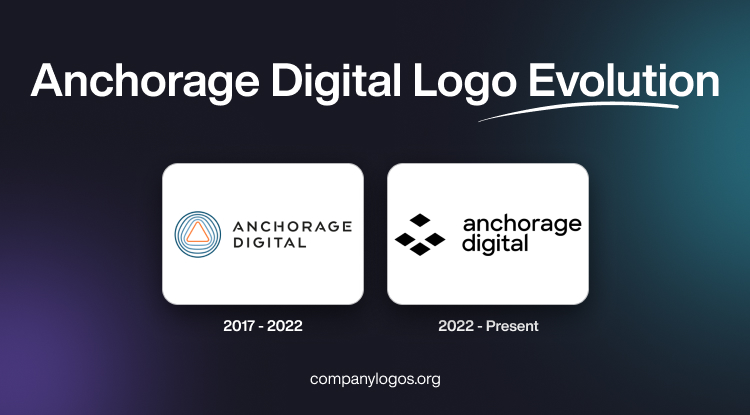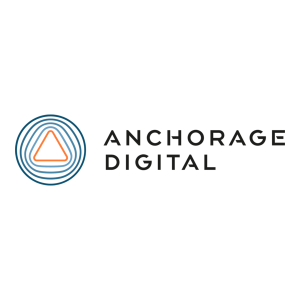
Anchorage Digital is a digital asset platform and federally chartered crypto bank that provides secure, regulated infrastructure for institutional investors. It was founded in 2017 by security engineers Diogo Mónica and Nathan McCauley. The company offers a full suite of services, which includes custody, trading, settlement, staking, and governance. Anchorage Digital has positioned itself as a trusted bridge between traditional finance and the rapidly evolving world of blockchain technology.
The logo of Anchorage Digital has evolved as the company moved from a crypto security startup into a regulated, institutional-grade digital-asset platform and (later) a federally chartered crypto bank. The article delves into the evolution of the two logos, among other details of the company.
The Genesis of the Anchorage Digital Logo (2017 – 2022)
The original Anchorage logo comprised a simple emblem and the brand name written in a clean sans-serif typeface. The graphical emblem emphasised security and institutional trust rather than bold consumer branding. It comprised a sequence of concentric abstract circles that took the shape of the triangular element at the centre with rounded corners.
The dual-coloured emblem had the triangle at the centre in orange, while the concentric figures were in blue. The wordmarks “ANCHORAGE” and “DIGITAL” in blue uppercase were placed in two levels to the right of the abstract emblem.

(2022 – Present)
To mark its fifth anniversary and global expansion (including a new engineering hub in Porto), Anchorage unveiled a new visual identity in late 2022. The new mark that continues to date is a stylised, abstract geometric emblem composed of four discrete blocks.
The emblem is paired with the lowercase wordmark “anchorage digital” set in a clean geometric sans-serif typeface. The four-block emblem represents the core tenets of the company: industry-leading security, regulatory leadership, custody as a foundation, and commitment to clients.

The Elements of the Anchorage Digital Logo
Font
The wordmark in the current logo is written in lowercase using a geometric sans-serif typeface to convey modernity, approachability, and technical clarity.
Colour
The four-block anchor logo and the wordmark are depicted in a high-contrast black and white colour combination.
The History of Anchorage Digital
Anchorage Digital was founded in 2017 by Diogo Mónica and Nathan McCauley, who were two security engineers with deep experience in building and scaling financial security systems at companies like Docker and Square. Their vision was to solve one of the biggest challenges in the digital asset space, that is, to secure custody for institutions.
At the time, most crypto custody solutions relied on cold storage, which was secure but slow and cumbersome for active investors. Anchorage created a more flexible model that combined strong cryptographic security with usability for institutions that needed to actively manage their assets.
Anchorage began as a crypto-native custodian offering digital asset custody that went beyond traditional hardware wallets and cold storage. Instead, it developed multi-party computation (MPC) and biometric-based security solutions that allowed institutions to store, transfer, and stake digital assets securely. In 2019, Anchorage formally launched out of stealth with support from prominent investors, such as Andreessen Horowitz (a16z), Blockchain Capital, and Visa.
As demand for digital assets grew, Anchorage expanded its services beyond custody. The company introduced staking for proof-of-stake cryptocurrencies, trading, governance participation, and financing solutions for institutional clients. These services positioned Anchorage as more than a custodian. In fact, it became an institutional platform for digital assets.
During this time, Anchorage also grew its client base to include hedge funds, venture firms, family offices, fintechs, and banks. This reinforced its reputation as a trusted partner in digital asset infrastructure.
In January 2021, Anchorage achieved a historic milestone when it became the first cryptocurrency company to receive a federal banking charter from the U.S. Office of the Comptroller of the Currency (OCC). With this charter, it launched the Anchorage Digital Bank National Association, which allowed it to act as a qualified custodian under U.S. law. Besides, it gave institutions the regulatory clarity they needed to confidently engage with digital assets. This recognition marked a turning point for Anchorage. It established its role as a bridge between traditional finance and the emerging digital asset economy.
Following its bank charter, Anchorage deepened relationships with fintech firms, banks, and institutional investors. It offered regulated custody and settlement services. It secured partnerships with major players in the crypto and financial ecosystem, which enabled institutions to securely engage with cryptocurrencies, NFTs, and other blockchain-based assets.
In 2022, Anchorage announced global expansion with a new engineering hub in Porto, Portugal, to tap into international talent. Around the same time, the company introduced a refreshed brand identity featuring the four-block anchor logo. The four-block anchor symbolised its four pillars of security, regulatory leadership, custody foundation, and client commitment.
Anchorage Digital operates as a regulated digital asset bank and platform that offers custody, settlement, trading, staking, and governance services to institutional clients worldwide. It has raised hundreds of millions in funding from leading venture capital firms and continues to position itself at the intersection of finance and blockchain technology.
The growth of Anchorage reflects the broader maturation of the crypto industry, that is, from early innovation and security challenges to mainstream adoption and regulatory integration. Anchorage has become a cornerstone for institutions seeking trusted access to digital assets by combining technical rigour with regulatory compliance.
Interesting Facts About Anchorage Digital
- Anchorage was founded in 2017 by security engineers Diogo Mónica and Nathan McCauley, who previously worked on security at Docker and Square. Their expertise shaped Anchorage into one of the first crypto-native institutional custodians.
- In January 2021, Anchorage made history by becoming the first cryptocurrency company to receive a federal banking charter from the U.S. Office of the Comptroller of the Currency (OCC). This made it the first federally regulated digital asset bank in the United States, which was a milestone that gave institutions confidence to engage with crypto in a compliant manner.
- Unlike most early custodians that relied on cold storage, Anchorage uses multi-party computation (MPC) and biometric-based authentication to keep digital assets secure. At the same time, it makes them accessible for activities like staking, governance, and trading.
- Anchorage has raised funding from top-tier investors, including Andreessen Horowitz (a16z), Visa, Blockchain Capital, and Khosla Ventures, which reflects strong confidence in its model.
- Anchorage also offers staking services for proof-of-stake tokens, trading and settlement, financing solutions, and governance participation for institutions.
- In 2022, Anchorage expanded internationally by opening an engineering hub in Porto, Portugal. It thus tapped into European talent and reinforced its global ambitions.
- Anchorage rebranded in late 2022, wherein it introduced its current four-block anchor logo. The four blocks symbolise the company’s pillars: security, regulatory leadership, custody foundation, and client commitment.
- Anchorage primarily serves institutional clients, such as hedge funds, venture capital firms, fintech companies, and banks. This focus differentiates it from consumer-facing exchanges.
- By offering regulated banking infrastructure for digital assets, Anchorage plays a vital role in connecting traditional finance (TradFi) with decentralised finance (DeFi).
Finally
The evolution of the Anchorage Digital logo shows the transformation of the company from a pioneering crypto custody startup into a federally regulated digital asset bank with global reach. Its modern four-block anchor emblem, introduced in 2022, symbolises stability, security, and institutional strength. The logo’s journey demonstrates a design progression as well as the company’s growth and credibility. It reinforces an enduring commitment to providing secure, compliant infrastructure for the future of finance.